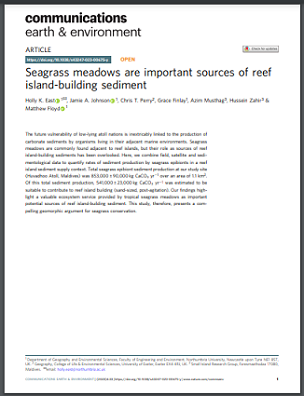
The future vulnerability of low-lying atoll nations is inextricably linked to the production of carbonate sediments by organisms living in their adjacent marine environments. Seagrass meadows are commonly found adjacent to reef islands, but their role as sources of reef island-building sediments has been overlooked. Here, we combine field, satellite and sedimentological data to quantify rates of sediment production by seagrass epibionts in a reef island sediment supply context. Total seagrass epibiont sediment production at our study site (Huvadhoo Atoll, Maldives) was 853,000 ± 90,000 kg CaCO3 yr−1 over an area of 1.1 km2. Of this total sediment production, 541,000 ± 23,000 kg CaCO3 yr−1 was estimated to be suitable to contribute to reef island building (sand-sized, post-agitation). Our findings highlight a valuable ecosystem service provided by tropical seagrass meadows as important potential sources of reef island-building sediment. This study, therefore, presents a compelling geomorphic argument for seagrass conservation.














